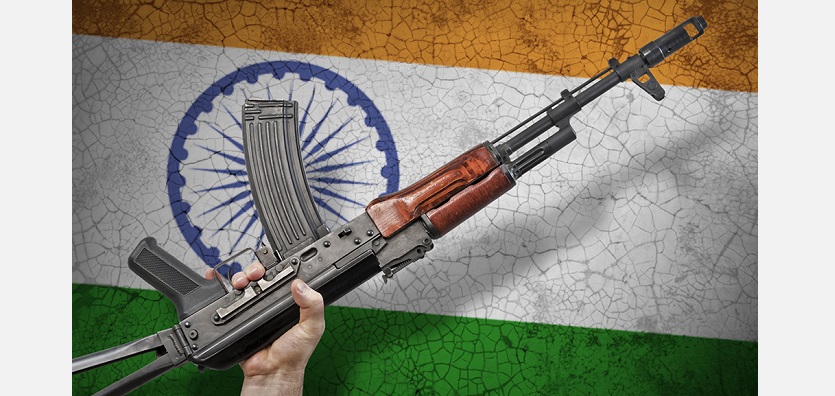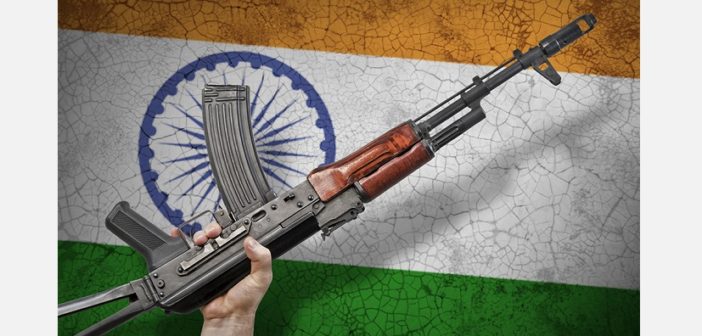

“by Sebastian Liu”
Just weeks after the Sri Lankan bombings, the Islamic State (IS) declared the establishment of a province in India, naming it the ‘Wilayah of Hind’.
The announcement followed the killing of a militant, Ishfaq Ahmad Sofi, during a security operation in the Shopian district of Jammu and Kashmir (J&K) earlier that day on May 10. Ishfaq was thought to have been a close associate of the leader of an IS-inspired group, known as the Islamic State Jammu and Kashmir (ISJK). Initial signs of IS presence in the conflict-ridden state were observed in 2016 after the IS flag appeared during several protests. This was followed in 2017 and 2018, when IS claimed responsibility for two separate attacks on the state’s security personnel, which resulted in two policemen being killed. These developments have spawned concerns about how real the threat of IS is in India’s northernmost state.
India has been fairly sheltered from the spectre of IS, with the group being linked to only a few low-intensity attacks in recent years. Notably, in 2017, an explosion targeted a passenger train near the Jabri railway station in Madhya Pradesh, wounding ten people. The incident was perpetrated by militants with alleged links to IS, though the authorities insisted that the militants were self-radicalised. Moreover, there is little evidence of IS possessing the operational capability to inflict significant casualties or damage in J&K. The security forces have indicated that the militants involved in the aforementioned 2017 and 2018 attacks on the Kashmiri security forces were merely inspired by IS ideology; this is in line with previous IS attempts at propaganda and is not reflective of the group’s resources and membership in J&K.
While the IS has issued a somewhat credible claim of responsibility for the April 21 Sri Lanka explosions, the May 10 Indian declaration appears to lack credibility. Compared to the IS proto-state that existed in Iraq and Syria, there is no semblance of such governance and territorial control in Jammu and Kashmir, let alone the rest of the country. Moreover, the Indian security forces have consistently maintained that the IS does not have a coherent membership base within J&K. While militancy is rife in the state, IS has not developed affiliations with any local Kashmiri separatist group, which have been waging an insurgency against the Indian government for decades.
Unlike in other countries, where IS has used local militant outfits to springboard operations, IS has failed to garner a pledge of allegiance from a Kashmiri separatist group. Groups that have done so have been known to adopt a more sectarian disposition and emulate its barbaric antics like beheadings. The key differentiator in J&K is that local separatist groups view their cause as a territorial dispute, rather than one that is based on religion. Accordingly, the differing ideological aims hamper the IS’s ability to recruit Islamist militants to its cause. The Indian Muslim community also largely refrain from discussing matters relating to the ongoing insurgency in J&K for fear of being perceived as Pakistani agents, further isolating the recruitment efforts of IS.
The heavy military presence, and frequent security operations against suspected militants in the state, also represent significant obstacles to the organisation of IS in J&K. J&K is one of the most militarised region in the world, with more than 500,000 security personnel being deployed across the state. The security forces possess robust intelligence capability, and actively monitor social networking sites, mobile phones, and surveillance footage to obtain intelligence on militant groups. Legislation, specifically the Armed Forces (Special Powers) Act 1958, grants further overarching powers to members of the security forces who can arrest individuals without a warrant and use undue force to effect the arrest, including the use of live ammunition. Frequent security operations, including pre-emptive raids targeting suspected militants, also serve to suppress the capabilities of militant groups in the state.
IS may have limited operational capability in the state for now, but it has shown a latent intent to widen its footprint in the country, and across the wider South Asia region. Separatist groups active in J&K tend to conduct attacks with the aim of attaining independence, or to seek the accession of the Muslim-majority state to Pakistan. However, contrary to these aims, IS carries out attacks with more religious undertones and views the whole of India as part of the Khorasan Province; this was included in a 2014 map of its planned caliphate. IS has demonstrated its desire to recruit and expand its presence in the area through its propaganda videos, many of which have featured subtitles in Tamil and Telugu.
The territorial defeat of IS in Iraq and Syria has driven the group to shift their attention towards South Asia. For example, IS has already established a capability in Afghanistan, reflecting its pattern of expanding into conflict zones where it is possible to foment radicalism, take advantage of underlying sectarian tensions, exploit security vulnerabilities, and recruit from the local Muslim community. The intent to expand their operational presence in South Asia is further evidenced by the recent spate of high-profile announcements and claims of responsibility, including the April 21 Sri Lankan bombings. Local militant groups in Sri Lanka are unlikely to possess the capability or operational expertise to conduct such a sophisticated attack, with many opining that external instruction from IS operatives was likely. Local media outlets have also indicated that a new emir (chief) of Bengal was appointed by the IS in late April, amidst threats to carry out attacks in India and Bangladesh.
The May 10 declaration, regardless of the operational capabilities of IS in-country, may have been an attempt to skew the perception of the ongoing Kashmiri insurgency away from its separatist origins and aggravate Muslim-Hindu tensions in the state. Under such circumstances, the disaffected segment of the Muslim-majority population in J&K would provide a conducive recruitment ground for IS. On the other hand, the group’s history of making unsubstantiated claims to capture media attention is well documented. Its grand declaration on May 10 is, more likely than not, an attempt at propaganda, one that requires minimal resources but with the potential to create fear and uncertainty in the region.
About the Author
Sebastian Liu is a Global Threat Analyst for Asia Pacific with Healix International Risk Management Services, a global risk management group headquartered in the United Kingdom






